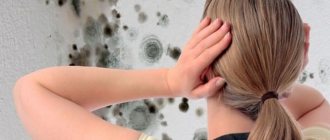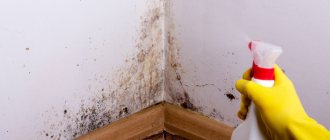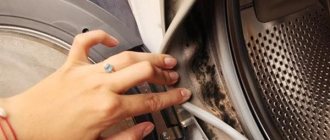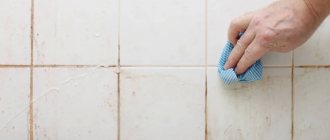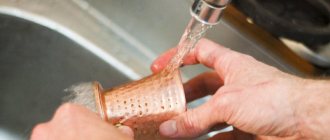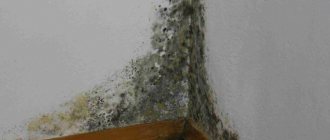Mold spores spoil any surface, worsening its appearance. But they also have a negative impact on human health. Therefore, when signs of fungal development appear, it is necessary to begin an active fight against it. In addition to special means, there are folk remedies that can solve this problem, including copper sulfate. But it is recommended to use it carefully. Therefore, it is worth figuring out how to use copper sulfate against mold.
What is vitriol and how does it happen?
In addition to copper sulfate, there are other types of vitriol. However, copper sulfate is used to eliminate fungal spores. It represents crystalline hydrates of sulfates. Actively involved in medicine, agriculture, and construction. Externally, vitriol resembles small crystals with a blue tint.
Copper sulfate is used to eliminate fungal spores.
Features of tree structure
The location of the fibers in wood helps the material to absorb quite well a large amount of moisture coming from the outside. In this way it is somewhat reminiscent of the properties of a sponge.
- In addition, the trunks, when they have just been cut down, necessarily contain remaining vital juices.
- While performing useful functions during the growth and development of a tree, after cutting, they, on the contrary, contribute to the deterioration of the properties of tree species, accelerating the process of their decay from the inside.
If the outside of a wooden product can be protected by applying varnish or painting it, then such a thin surface film can provide protection exclusively for the outside.
But it is not capable of beneficially influencing processes of a biological nature in the internal part of a wooden structure.
A more significant effect can be obtained if you use biocidal-based antiseptic substances for these purposes. Copper sulfate, for example, or as it is also called copper sulfate, is quite often used in these cases in practice.
What properties does copper sulfate have?
It was noted that copper sulfate is used in medicine, as well as in the agricultural sector. However, it also found use in everyday life. It is often used to remove traces of mold. Suitable even for wood. Copper sulfate can also remove traces of rust. Can be used to prevent the formation of fungus. Among the key properties of the substance are antiseptic.
Copper sulfate can be used to prevent the formation of fungus.
Preventive treatment against fungus
Copper sulfate is a folk remedy that will help remove fungus at any stage of its development.
The use of vitriol is possible not only to eliminate fungus in the apartment, but also to prevent its occurrence.
Once or twice a year, apply a copper sulfate solution to walls that are prone to mold. It is preferable to do this in the autumn-spring period, when dampness in apartments increases due to the lack of central heating.
The solution cannot be applied to walls covered with wallpaper.
Copper sulfate is also used for preventive purposes in construction: the working solution is applied to the wood even before the construction of the building. This measure helps protect vulnerable material from fungus and rot.
Watch the video on how to remove fungus in an apartment using copper sulfate.
Causes of mold and mildew on walls
Mold can actively spread over the surface. If the necessary measures are not taken to solve the problem, the health of a person living in such conditions may worsen, even to the development of bronchial asthma. But the fungus does not begin to actively develop in all rooms. Favorable conditions are important for him. One of the common causes of mold development is a humid environment. In rooms with high air humidity, spores multiply more actively, penetrating deeper into the surface layers, reliably attaching themselves there.
A humid environment occurs due to constant temperature changes, regular freezing of the room, and wetness of various surfaces. The lack of a quality ventilation system only exacerbates the problem. Therefore, fungus can appear for the following reasons:
- Severe dampness in the room;
- Lack of good ventilation;
- Some parts of the room are not warm enough.
The apartment can be cozy and warm, but even if at least one corner gets wet or freezes, this is enough for mold to actively spread.
A common cause of mold development is a humid environment.
The main causes and signs of mold in the apartment
The cause of mold in an apartment is high humidity, warm air, malfunction of the ventilation system.
Mold in the washing machine: diagnosis or death sentence?
The appearance of fungus on the outer panels of the house or on the ceilings indicates a defect in the building materials or poor-quality masonry, poor-quality seams between the panels. The basis for the formation of plaque may also be uninsulated walls, freezing of the panel, or accumulation of condensation between the seams. Fungal plaque forms on concrete, brick and wooden walls, with high humidity and poor ventilation.
In the bathroom, toilet room, and kitchen, mold also appears due to excess humidity and poor ventilation. The cause may be a lack of tightness, leaking water pipes, faulty ventilation, poor-quality sealing of the junction of the bathtub and the wall facing material, or leaking sewer pipes. If the seal is broken, water leaks through it. This leads to the formation of puddles in poorly ventilated areas of the bathroom, causing rot and dampness. Continuous accumulation of water in bathroom floor joints will cause water to leak into the lower floors or basement.
If the apartment is on the lower floors or a private house, the cause of excess humidity may be a damp basement.
Damage to the walls of a house by mold fungi has characteristic signs:
- The first sign of presence is the damp smell of the “cellar”;
- Fungal plaque quickly grows in the affected areas and destroys the affected material.
There are different ways and methods of combating fungal mold removal, the most popular due to its effectiveness and efficiency is treating the affected surfaces with an aqueous mixture of copper sulfate.
What can mold cause in your home?
It was noted that the presence of mold can adversely affect health. Spores have a negative effect on the human body for a long time.
Among the common problems that result from constant inhalation of fungus, it is worth noting:
- Development of allergies;
- Decreased general level of immunity;
- Migraine;
- Exacerbation of diseases associated with the lung and bronchial system;
- Development of respiratory diseases.
That is why it is necessary to immediately begin eliminating fungal spores. When primary signs of their presence appear in the house.
The presence of mold can adversely affect your health.
The danger of fungus and mold in living spaces
The main danger of mold and mildew indoors is in spores that begin to spread in the air, settle on people’s skin, and enter the body through breathing, where they can be the source of many diseases.
Such diseases may include:
- rashes on the skin;
- eczema;
- dermatitis;
- damage to hair and nails;
- allergic rhinitis;
- cough;
- allergic conjunctivitis;
- musculoskeletal disorders;
- cause problems in the digestive system;
- if it gets into the blood, it can cause intoxication of the body;
- disturbances in the functioning of the genitourinary system.
And if in adults such diseases can be mild, then in children (especially those with weakened immune systems) all of the above diseases can be more severe and also cause serious complications. Therefore, you should get rid of fungus in your apartment as quickly as possible.
What vitriol should be used against mold and where to get it
Treatment with copper sulfate is usually carried out for mold problems. It is not used in its original form, but after mixing with water, becoming a solution. You can buy crystals in different packaging in stores that sell building materials, household supplies and gardening products.
It is not used in its original form, but after mixing with water, becoming a solution.
How much does it cost and where can I buy copper sulfate?
Copper sulfate is not a scarce commodity. It can be purchased at any hardware store, as well as at specialized retail outlets for gardeners and gardeners.
The packaging design of copper sulfate may vary
Copper sulfate is an inexpensive antiseptic. When purchased in bags (25 kg), the price ranges from 139 to 193 rubles/kg. The cost of a small package at different retail outlets may vary:
- 50 g - from 25 to 32 rubles;
- 100 g - from 33 to 65 rubles;
- 200 g - from 75 to 106 rubles;
- 500 g - about 240 rub.
Advantages and Disadvantages Compared to Other Mold Remedies
This remedy has been used for many years to eliminate fungal spores. This popularity is associated with a number of advantages, including:
- Good efficiency;
- Low cost of the method;
- Variety of product packaging. You can purchase it in a convenient quantity;
- Easy to use;
- Practicality;
- Protection against re-development of fungus.
One of the disadvantages of the product is that it should only be used in untreated cases. Vitriol will not cope with old, deep traces of mold. It is also necessary to use protective equipment when working with this product, otherwise you may get poisoned.
It is imperative to use protective equipment when working with this product, otherwise you may get poisoned.
Benefits of Copper Sulfate
Copper sulfate, or copper sulfate, is considered one of the most effective means for treating premises against mold. It has a pronounced antiseptic effect, which allows it to successfully fight the parasite. Also, another important advantage that copper sulfate has over other means is its low price. It is several times cheaper than industrial combined antiseptics, but is not at all inferior to them in effectiveness. Copper sulfate is sold in gardening stores or wherever building materials are available.
Copper sulfate comes in the form of a powder consisting of bright blue granules of varying sizes. To make a solution of copper sulfate, you need to stir the granules in warm water until they are completely dissolved. It is best to do this in proportions of 20 grams of powder per 1 liter of water. For the greatest benefit, you can also add 5 ml of acetic acid per liter, any chlorine-containing bleach, or a few drops of grapefruit, monarda or tea tree essential oil to this solution. With their help, you can enhance the antibacterial effect of vitriol and prolong the anti-mold effect.
See also: Is it possible to get rid of the smell of mold on things?
It should be remembered that copper sulfate is a caustic, dangerous substance, so when working with it you must cover your eyes and hands and use a respirator to avoid poisoning.
Signs of the negative effects of copper sulfate:
- Weakness;
- Dizziness;
- Unpleasant sensations in the stomach area;
- Tachycardia;
- Allergy;
- Nausea and vomiting.
However, despite such strong toxicity, copper sulfate is considered one of the most popular parasite control methods that can be used at home.
The shelf life of an already prepared copper sulfate solution reaches one year in a cool place. It should be remembered that this substance should not be stored in metal containers. For copper sulfate, it is necessary to prepare a glass or ceramic container so that the solution of copper salts does not react with the walls of the container.
What surfaces can it be used on?
A feature of the product is its versatility. It is suitable for various surfaces, including wood, concrete, brick, stone. You can also process drywall and gypsum fiber.
Do not use copper sulfate on metal parts or surfaces. This may trigger a chemical reaction.
Do not use copper sulfate on metal parts or surfaces.
Other types of antiseptic substances
Copper sulfate has a distinct crystalline form. It is easy to recognize by its characteristic bright blue color.
It is immediately worth noting that metal should not come into contact with it. It is never used on surfaces that contain metal fasteners.
If it is bred for processing, then they never use metal containers. When interacting with it, ferrous metal elements always experience severe corrosion.
If we talk about alternative possible methods, then they are antiseptic substances with an oil base, as well as bitumen. After exposure, the wood acquires good resistance to negative biological influences. However, they are not able to make a wooden structure decorative.
- The most famous oil antiseptic is creosote. This liquid smells extremely unpleasant. Has a slight yellow tint. It is produced from tar, which in turn is obtained from wood or coal.
- This substance is familiar to almost everyone, since wooden sleepers on the railway are impregnated exclusively with this composition. The advantage is that during processing, metal parts are not damaged.
- But carpentry and interior decoration are an exception, which can be explained by both the unpleasant smell and the unaesthetic appearance. In addition, creosote has been found to have toxic properties.
It contains harmful compounds phenol-formaldehyde. The volatility of the released toxins is very harmful to humans.
Instructions for use
When purchasing copper sulfate, it comes with instructions regarding the nuances of its use. The information should be carefully studied and the recommendations provided should be strictly followed.
To treat with vitriol, you need to prepare a special solution. Use a container made of plastic, glass or ceramics in which you do not plan to cook food later. The solution is diluted in proportions of 1:100, where for 10 liters of water you need to take 100 g of vitriol crystals. If the fungal infection is not initial, but more severe, it is worth preparing a more concentrated product. Then the proportions change and the ratio becomes 3:100.
First, add a little preheated water to the prepared amount of copper sulfate. Mix everything with a spatula and strain. Then add the rest of the liquid.
If the fungal infection is not initial, but more severe, it is worth preparing a more concentrated product.
What you need to remove mold using vitriol
Before you begin the troubleshooting process, you need to prepare everything you need in advance. This will allow you not to forget anything and approach the matter in a more organized manner.
To deal with mold, you need to prepare the following:
- Ready solution. It is enough to mix all the ingredients in one suitable container. To increase efficiency, it is recommended to add about 200 ml of vinegar per 10 liters of water to the finished composition;
- Tools with which the product will be applied to the surface. A spray bottle will do. It is the most convenient for such a process. But you can also use a brush or sponge;
- A spatula and a metal brush, allowing you to clean the affected areas;
- Means for protecting the body. In addition to clothing that covers all parts of the body, you need to equip yourself with gloves and a mask.
When these items are prepared, the process of eliminating the fungus problem begins.
Before you begin the troubleshooting process, you need to prepare everything you need in advance.
Processing order
You should follow the procedure and instructions for use when treating a room with a fungicidal composition:
- Dissolve from 100 to 400 grams of vitriol in 10 liters of warm water, stir until completely dissolved;
- Using a roller or paint brush, or simply a sponge, apply the prepared composition to the entire surface to be treated, then dry;
- Dry for 5-6 hours or with a hair dryer. You can apply the finished mixture using a brush, roller, sponge or spray;
- You can apply up to 5 layers, but after each layer you need to maintain a drying time.
- You can use the treated room no earlier than after 2 days; ventilate well first.
Preparing walls for processing
The fight against fungus begins with surface preparation. This will speed up the process and increase its efficiency. First, you should ensure maximum ventilation in the room. To do this, turn on the hood and open the windows as much as possible. Surfaces affected by spores are freed from covering, wallpaper is removed, paint and plaster are cleaned. If the fungus has managed to penetrate deeply inside, then you should additionally clean the areas with sandpaper.
Treat problem areas with a soap solution and leave to dry completely. This stage should not be neglected, especially if black mold has begun to develop. Finally, you must put on the prepared personal protective equipment.
If the fungus has managed to penetrate deeply inside, then you should additionally clean the areas with sandpaper.
How to get rid of mold on walls?
First of all, to get rid of fungus on the walls, you need to do a thorough cleaning. It is necessary to remove all contaminated areas and, if possible, get rid of finishing materials and furniture that have become infected.
If it is not possible to dispose of items, they must be cleaned as much as possible and treated against mold, otherwise it will grow again after a short time.
To clean the walls, it is better to use a stiff brush, scraper or metal sponge. It is worth remembering that during cleaning, spores are widely scattered through the air, therefore, to prevent them from entering the body, you should wear personal protective equipment when working, such as a respirator, safety glasses and rubber gloves. It is also a good idea to wet the surface to be treated with water or soapy water in advance. This will bind mold and dirt and prevent small dust particles and spores from spreading throughout the room. In addition, this action will significantly speed up and facilitate the cleaning process, as well as increase the effectiveness of treatment with anti-mold preparations, especially if the solution is treated with copper sulfate.
See also: How can I get rid of mold on fabric?
The next step is to apply an antiseptic to the affected surface. It can be either a special fungicidal household chemical for treating various surfaces, or a separate substance with an antibacterial effect.
Bleach and chlorine-containing bleaches, copper sulfate, hydrogen peroxide, ammonia and borax are often used as folk methods for getting rid of this problem.
Antifungal medications can be applied using a spray bottle or a wide paint brush. Processing can also be carried out using a soft roller.
It is advisable to treat with an antiseptic in several layers, allowing each of them to dry completely before subsequent application. This will increase the effectiveness of the product and increase the chances that mold will not form again in the future.
After the solution of copper sulfate against fungus on walls and other surfaces has completely dried, you can begin decorating the room. In this case, a special antiseptic primer and putty, as well as antifungal wallpaper glue, are usually used. By using this, you can enhance the effectiveness of the treatment and increase the chances of completely preventing the problem from returning.
Treatment and application
When the surface is prepared, you should start applying vitriol. If you use a spray bottle, just spray the solution onto the desired area. You can apply the product with a sponge, wetting it in the composition and wiping the desired area. Processing should be plentiful. After 4-5 hours, when the surface has dried, it is worth repeating the procedure. The solution is applied again.
The number of repeated treatments after the composition has dried depends on the degree of fungal development. If there is a lot of mold and it has become embedded in the surface, then you will have to repeat the procedure many times. On average, the number of repeated treatments is reduced to 2-5 pieces.
If the spore damage is serious, then in addition to removing the cladding, you must first completely clean off the plaster. Only after this can you begin to treat the area with the solution.
If you use a spray bottle, just spray the solution onto the desired area.
Prices for professional mold removal
| Room area | Impregnation | Mechanical stripping | Disinfection from spores | Microwave drying of walls | Complex (3 year warranty) |
| 1-2 sq.m. | from 1000 rub. | from 1000 rub. | from 500 rub. | from 2000 rub. | from 3500 rub. |
| 3-5 sq.m. | from 800 rub. | from 850 rub. | from 350 rub. | from 2000 rub. | from 3000 rub. |
| 5-10 sq.m. | from 650 rub. | from 700 rub. | from 200 rub. | from 1800 rub. | from 2800 rub. |
| 10-20 sq.m. | from 500 rub. | from 600 rub. | from 100 rub. | from 1500 rub. | from 2500 rub. |
| 20-50 sq.m. | from 400 rub. | from 500 rub. | For a present* | from 1500 rub. | from 2500 rub. |
| 50-100 sq.m. | from 300 rub. | from 500 rub. | For a present | from 1500 rub. | from 2000 rub. |
| More than 100 sq.m. | negotiable | ||||
| LINEAR METER (along the baseboard, along the seams, along the joints of the walls) | 1000 rub. |
What can you mix with?
In order to increase the effect, some other ingredients are added to the finished composition. This could be 200 ml of vinegar, which will have a positive effect on the processing result. It is also permissible to mix copper sulfate with a few drops of tea tree oil or a small amount of detergent that contains chlorine.
The connection cannot be made with other substances. An undesirable reaction may occur. Also, the prepared solution can be stored for about 3 months on the shelf. If you place the container in the refrigerator, you can preserve the composition for a year. It is important to ensure that the lid is well closed and the solution is in a place that is difficult to reach for children and animals.
To increase the effect, add 200 ml of vinegar, which will positively affect the result of the treatment.
Surface preparation
Before treating walls with copper sulfate, it is necessary to prepare the surface. This should be done as follows:
- We are looking for the source of the spread of mold (mycelium). It may be located in hard-to-reach, inconspicuous places (for example, behind tiles). During the search, we tap the tiles. Each hollow area is one of the probable areas where the mycelium is located.
- We remove wallpaper, tiles or other finishing material from the walls.
- Use a spatula or a stiff brush to clean the surface. Then we carry out another cleaning - this time with fine-grained sandpaper.
- We treat the surface with soapy water and let it dry. In the end, you need to get a perfectly clean and dry surface.
How long does the result last?
The duration of the result depends on many conditions. It is important not only to treat the surface, but also to organize everything in such a way as to prevent the fungus from re-developing. It is necessary to exclude high humidity, lack of ventilation and freezing, wetting of surfaces. Then the result from the process will last a long time. If favorable conditions for the spread of spores reappear, then such treatment will have to be repeated constantly. The result will not be long-term.
It is necessary to exclude high humidity, lack of ventilation and freezing, wetting of surfaces.
Preventive measures
In order for the treatment to give the desired result, preventive measures must be taken. This will reduce the likelihood of the fungus developing again and prolong the positive effect of vitriol.
There are a number of measures that will allow you to forget about the problem of mold spread. Among them:
- Regular ventilation of the room. This applies even to the winter period;
- Providing good ventilation;
- Avoiding hypothermia of walls;
- Make sure that the increase in humidity in the room does not last long;
- Monitoring the condition of plumbing. It must always be in good working order;
- Regular and careful maintenance of the water supply system;
- When carrying out repairs, it is necessary to use materials whose compositions are resistant to moisture. It is also recommended to use antiseptics;
- When arranging furniture, leave a small distance between objects and windy walls. Then the air will circulate without obstacles, freely;
- In rooms with significant levels of humidity, it is worth limiting the number of flowers to a minimum.
If the room has plastic windows, then you should take care of high-quality ventilation. Especially if the cladding is made of tiles or plastic panels.
When arranging furniture, leave a small distance between objects and windy walls.
Precautionary measures
Copper sulfate is toxic and should be handled very carefully:
- Prepare the antifungal mixture immediately before use and use within 10 hours.
- Prepare the mixture and store it not in a metal container. Copper corrodes iron and other metals.
- Toxic fumes of copper sulfate cause poisoning and vomiting, use with caution. Follow safety precautions, wear a respirator or mask on your face. Do not allow the powder to become dusty during work; after finishing the treatment, you must wash your face.
- The powder itself is harmless to dry skin, but it must be washed off. Wear rubber gloves and closed clothing.
- While treating the room with an antibacterial composition, turn on the hood or open the window.
- If you are poisoned by copper salt vapors, consult a doctor immediately.
Dangerous black mold: how to get rid of the uninvited “guest”?
After treating the room with a solution of sulfuric acid salt, do not allow conditions for the reappearance of the fungus. Monitor humidity, air exchange and temperature in the room. Leave gaps between the wall and furniture for air circulation. Monitor the condition of water pipes and plumbing fixtures. Ventilate the apartment regularly. After high-quality treatment of the walls with an antifungal composition and compliance with the above conditions, the re-formation of mold fungi is excluded.
Safety precautions at work
In pursuit of getting rid of a fungal problem, it is important to remember your own safety. Therefore, it is necessary to carefully follow all recommendations so as not to harm the body when treating the affected areas.
Among the basic safety rules it is worth noting:
- Gloves must be worn at the stage of preparing the solution, when the crystals are mixed with water. Not only rubber products are suitable, but also latex ones;
- The airways need protection. A respirator would be ideal. But if you don’t have it at hand, you definitely need to put on a gauze bandage and make an improvised mask from it;
- Eyes also need protection. That’s why it’s worth arming yourself with plastic glasses;
- It is not necessary to use special protective overalls. Regular clothing will do. The main thing is that it tightly covers all areas of the body completely. After use, it must be washed;
- All windows and doors must be opened when working. You should also open the windows and turn on the ventilation;
- Animals must be removed from the room and children taken away.
Following these rules will allow you to avoid poisoning and maximize your health while working.
In pursuit of getting rid of a fungal problem, it is important to remember your own safety.
Copper sulfate to combat mold
Copper sulfate is copper sulfate (copper sulfate). This chemical is well known to gardeners as a fungicide that protects plants from fungal diseases. But besides this, it is also effective for destroying mold on the walls of the house and in non-residential premises: in the attic, in the basement, in the cellar.
We recommend: How to treat a fence
Destruction of mold using copper sulfate treatment
Copper sulfate is an excellent antiseptic. With its help, you can effectively fight mold in any room of the house, as it is suitable for treating different surfaces:
- tree,
- concrete,
- brick or stone masonry,
- drywall.
When cleaning the basement, you can spray the solution onto the dirt floor.
But it is not recommended to expose the metal to copper sulfate; this can lead to defects on the surface being treated.
The effect of copper sulfate, according to reviews, is effective for any type of mold: black or white, which is more often found in unheated rooms.
In the garden, copper sulfate is used as a fungicide to combat fungal diseases. It is recommended for spring and autumn spraying of trees, shrubs and some types of flowers, for cultivating soil after late blight; used as a preventive and therapeutic agent. They can also disinfect gardening equipment and carry out sanitary cleaning of greenhouses.
How to use vitriol solution to combat mold indoors
How to breed
In most cases, a 1% solution of copper sulfate is used to treat surfaces against mold fungus. In case of severe contamination of the premises, the concentration can be increased to 3%!
How to process
Work order:
- Clean the surface to be treated from mold deposits. This operation is performed mechanically. You can use a scraper, spatula, stiff brush, sandpaper. Cleaning must be carried out using personal protective equipment: rubber gloves and a breather, since the concentration of mold spores in the air will be very high and breathing such a mixture is harmful to health.
Copper sulfate effectively affects only fungal spores, and not its overgrown colony, so mechanical surface treatment is mandatory
- Wash the affected areas with soapy water (40 g of laundry soap per 1 liter of water) and let dry.
You can wash the surface using an ordinary sponge.
- Prepare a working solution:
- pour 100 g of copper sulfate into a small clean container (glass, ceramic or plastic) (to obtain a 1% concentration);
- pour half a liter of warm water (no more than 50ºC) and stir everything thoroughly until the powder is completely dissolved; You can stir with a wooden or plastic spoon;
- filter the solution so that there are no undissolved particles left in it;
- pour the purified liquid into a large container (plastic bucket or spray bottle) and add warm water so that the total volume is 10 liters;
- mix thoroughly again;
- To enhance the disinfecting effect, you can add table vinegar (10 tbsp) to the solution.
- Apply the solution to the prepared surface. This can be done with a brush, roller or sprayer.
- We ensure complete drying of the surface, the duration of which can be from 5 to 12 hours. We re-treat with copper sulfate. If necessary, this operation can be performed several times.
Long surfaces are easier to treat with a sprayer
- You can start decorating the walls no earlier than 2 days after disinfection.
How much does it cost and where can I buy copper sulfate?
Copper sulfate is not a scarce commodity. It can be purchased at any hardware store, as well as at specialized retail outlets for gardeners and gardeners.
The packaging design of copper sulfate may vary
Copper sulfate is an inexpensive antiseptic. When purchased in bags (25 kg), the price ranges from 139 to 193 rubles/kg. The cost of a small package at different retail outlets may vary:
- 50 g - from 25 to 32 rubles;
- 100 g - from 33 to 65 rubles;
- 200 g - from 75 to 106 rubles;
- 500 g - about 240 rub.
Safety rules when working with copper sulfate
Copper sulfate belongs to hazard class 3 and when working with it it is necessary to observe the following precautions:
- when conducting all operations (preparation of working solution, processing), it is necessary to wear protective rubber or latex gloves;
- the respiratory tract must be protected with a respirator or, in extreme cases, with a thick gauze bandage or petal;
- To protect the organs of vision, use special protective plastic glasses;
- the body should be covered as much as possible with clothing, which must be washed after completion of work;
- You can only work in a well-ventilated area with ventilation turned on, windows and doors open. In the bathroom, be sure to leave the door open and open the windows of the rooms;
- There should be no other people, as well as children and pets in the room.
Copper sulfate and its solution should be stored in places inaccessible to children and pets.
Symptoms of copper sulfate poisoning
Despite the slight toxicity of copper sulfate, if safety regulations are not followed, poisoning with this substance is possible. The degree of damage depends on the route of penetration of the poison into the body and its concentration. The most dangerous is oral poisoning (through the mouth). But exposure through the respiratory tract or through the skin can lead to serious consequences.
Poisoning can manifest itself as follows:
- inflammation of the mucous membranes of the nasal cavity and eyes, lacrimation, sneezing;
- labored breathing;
- increased body temperature, accompanied by heavy sweating;
- increased heart rate;
- migraine, dizziness;
- weakness;
- allergic rash.
In medicine, the symptoms of copper poisoning through the respiratory tract have a special name - “copper fever”.
If copper sulfate enters the body through the gastrointestinal tract, other symptoms appear:
- pain in the abdomen;
- nausea and vomiting;
- disorder of the digestive system.
At a low concentration of the toxic substance, these signs will be weakly expressed. In this case, a slight malaise caused by exposure to copper can be confused with a regular ARVI.
Why do many people use copper sulfate to combat mold?
The antiseptic properties of copper sulfate and the effectiveness of its fight against fungal infection have been time-tested. Despite the development of household chemicals and the emergence of new high-quality drugs, this product is in great demand.
Table: pros and cons of using copper sulfate
| Advantages | Flaws |
| Low cost. | It is ineffective when affecting the mycelium of fungi; it completely destroys only their spores. |
| No problem purchasing. | Small depth of processing of porous materials |
| Does not require special knowledge when using. | When using it is necessary to comply with safety rules |
| It is a good antibacterial and antiseptic agent. |
Analogue antiseptics: iron sulfate, lime, hydrogen peroxide and others
There are other folk remedies that can be used to combat mold in the home.
Table: folk antifungal remedies
| Drug name | Features of application |
| Inkstone. | Iron sulfate is an excellent antiseptic and antibacterial agent and is used in the same way as copper sulfate. Iron salts are less toxic to humans than copper, but their excess in the body is also undesirable. May be explosive if improperly stored. |
| Lime. | Lime is often used as a preventive agent to combat mold and mildew: they whitewash the walls of basements, cesspools, tree trunks, and add it to the plaster of the interior of the house. To increase efficiency, lime can be mixed with copper sulfate. The process of slaking lime is used when fumigating a cellar. |
| Ammonia. | This product is recommended to be used to destroy mold spores on smooth, non-porous materials: glass, tiles. Ammonia is not suitable for concrete and wood. It must be taken into account that its vapors are hazardous to health. To work, alcohol is mixed with water in a 1:1 ratio. |
| Borax. | Borax solution can be used to treat any surface. The working solution is prepared from a ratio of 300 g of borax to 2 liters of water. The vapors of this substance are not dangerous to humans. |
| Hydrogen peroxide. | To combat mold, use a 3% peroxide solution without diluting it with additional water. The product is used for any materials, including fabrics. It has a slight whitening effect. Absolutely safe. |
| Baking soda. | A safe and cheap remedy, effective for minor fungal infections. To treat the surface, prepare a working solution: 1/2 tbsp. l. for 2 liters of water. |
| Whiteness (chlorine bleach). | Perfectly removes fungal spores from the surface of non-porous materials. But the use of whiteness requires special safety measures, since both the solution and the vapors of this product are very toxic. |
| Table vinegar. | Acetic acid is a good antibacterial agent. It is applied with a cotton swab or sponge (without diluting with water) and left for 1 hour, after which it is washed off. |
The described folk remedies will help destroy traces of mold. But for complete protection it is necessary to create conditions that prevent its occurrence. The premises should be dry and well ventilated; the appearance of condensation on walls or other surfaces is undesirable, since high humidity promotes the spread of fungal spores.
We recommend: Dinitrol - protects the WHOLE car from corrosion
Is vitriol dangerous, and what are the symptoms of poisoning?
Vitriol is classified as hazard class 3. That is why it is so important to take procedures using it seriously. You should not neglect safety measures. Poisoning may occur. It is important to recognize illness quickly and early. With the negative impact of vitriol on the body, nausea and vomiting occur. The heartbeat quickens, severe weakness appears. Pain in the stomach area may also occur. Pain sensations are affected by the degree of poisoning. It can be mild, aching or sharp and sharp.
The most dangerous symptoms are an allergic reaction and toxic shock. It is important to call for help in time and consult a doctor. Any contact with vitriol should be stopped as soon as the first signs of poisoning appear.
Any contact with vitriol should be stopped as soon as the first signs of poisoning appear.
Copper sulfate has long been used to combat fungal spores. And it has proven its effectiveness. He will not be able to cope with a serious, long-standing fungus alone. But not in severe cases, it is quite suitable for solving the problem. The main thing is to protect the body from the negative effects of the product so that the process is not only effective, but also safe.
Pros and cons of the product
Among the advantages of using copper sulfate as a fungicide are:
- availability. Vitriol is inexpensive and can be found in many hardware and construction stores;
- ease of use. Does not require the purchase of specialized equipment and components. CuSO4 is simply diluted in warm water to the desired concentration and applied manually or with a sprayer;
- efficiency. Copper sulfate effectively destroys mold on wood and other materials. It is still widely used in construction and everyday life for the treatment and destruction of fungal spores;
- if all recommendations are followed and the causes of mold are eliminated, there will be no relapses at the treatment sites;
- relative safety. Copper sulfate is non-toxic and safe in small quantities, has no odor, and does not corrode the skin upon direct contact (unlike products with chlorine).
Disadvantages include ineffectiveness against fungal mycelium. That is, vitriol treatment will kill mold spores and stop widespread spread, but the body of the fungus itself will remain. That is why, before application, maximum dismantling of contaminated areas of the surface and finishing material is required.
Attention! We must not forget about the causes of mold formation. The fungus will appear again if the room has high humidity, insufficient heating, poor ventilation or no ventilation at all.
